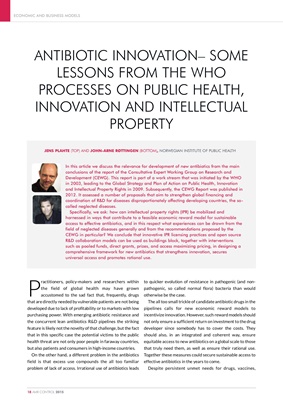
ECONOMIC AND BUSINESS MODELS
18 AMR CONTROL 2015
P
ractitioners, policy-makers and researchers within
the field of global health may have grown
accustomed to the sad fact that, frequently, drugs
that are directly needed by vulnerable patients are not being
developed due to lack of profitability or to markets with low
purchasing power. With emerging antibiotic resistance and
the concurrent lean antibiotics R&D pipelines the striking
feature is likely not the novelty of that challenge, but the fact
that in this specific case the potential victims to the public
health threat are not only poor people in faraway countries,
but also patients and consumers in high-income countries.
On the other hand, a different problem in the antibiotics
field is that excess use compounds the all too familiar
problem of lack of access. Irrational use of antibiotics leads
to quicker evolution of resistance in pathogenic (and nonpathogenic,
so called normal flora) bacteria than would
otherwise be the case.
The all too small trickle of candidate antibiotic drugs in the
pipelines calls for new economic reward models to
incentivize innovation. However, such reward models should
not only ensure a sufficient return on investment to the drug
developer since somebody has to cover the costs. They
should also, in an integrated and coherent way, ensure
equitable access to new antibiotics on a global scale to those
that truly need them, as well as ensure their rational use.
Together these measures could secure sustainable access to
effective antibiotics in the years to come.
Despite persistent unmet needs for drugs, vaccines,
ANTIBIOTIC INNOVATION- SOME
LESSONS FROM THE WHO
PROCESSES ON PUBLIC HEALTH,
INNOVATION AND INTELLECTUAL
PROPERTY
JENS PLAHTE (TOP) AND JOHN-ARNE RØTTINGEN (BOTTOM), NORWEGIAN INSTITUTE OF PUBLIC HEALTH
In this article we discuss the relevance for development of new antibiotics from the main
conclusions of the report of the Consultative Expert Working Group on Research and
Development (CEWG). This report is part of a work stream that was initiated by the WHO
in 2003, leading to the Global Strategy and Plan of Action on Public Health, Innovation
and Intellectual Property Rights in 2009. Subsequently, the CEWG Report was published in
2012. It assessed a number of proposals that aim to strengthen global financing and
coordination of R&D for diseases disproportionately affecting developing countries, the socalled
neglected diseases.
Specifically, we ask: how can intellectual property rights (IPR) be mobilized and
harnessed in ways that contribute to a feasible economic reward model for sustainable
access to effective antibiotics, and in this respect what experiences can be drawn from the
field of neglected diseases generally and from the recommendations proposed by the
CEWG in particular? We conclude that innovative IPR licensing practices and open source
R&D collaboration models can be used as buildings block, together with interventions
such as pooled funds, direct grants, prizes, and access maximizing pricing, in designing a
comprehensive framework for new antibiotics that strengthens innovation, secures
universal access and promotes rational use.